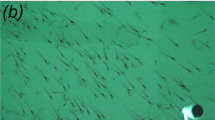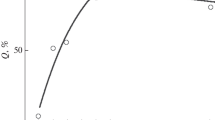Abstract
Antarctic krill,Euphausia superba, often exhibit abnormal behavior in laboratory aquaria, usually hovering in a stationary position, unresponsive to most external stimuli. In the austral summer of 1985–1986 at Palmer Station on Anvers Island, Antarctica, we provided laboratory conditions which inducedE. superba to school in large aquaria. Captive krill swam horizontally and exhibited the full spectrum of behaviors normally displayed while schooling at sea. Schooling krill avoided visually contrasting stimuli, with avoidance distances correlated with stimulus size. Schools responded in qualitatively different ways to presentations of food, chemical compounds, and abrupt increases in light intensity. We describe the conditions necessary for aquarium schooling and discuss the importance of an appropriate social environment for displays of escape, avoidance, and feeding behaviors and of positional preference within the school.
Similar content being viewed by others
Literature cited
Antezana, T., Ray, K., Melo, C. (1982). Trophic behavior ofEuphausia superba Dana in laboratory conditions. Polar Biol. 1: 77–82
Hamner, W. M. (1984). Aspects of schooling inEuphausia superba. J. Crustacean Biol. 4 (Spec. No. 1): 67–74
Hamner, W. M. (1988). Biomechanics of filter feeding in the Antarctic krillEuphausia superba: review of past work and new observations. J. Crustacean Biol. 8: 149–163
Hamner, W. M., Hamner, P. P., Strand, S. W., Gilmer, R. W. (1983). Behavior of Antarctic krill,Euphausia superba: chemoreception, feeding, schooling, and molting. Science, N.Y. 220: 433–435
Ikeda, T. (1985). Life history of Antarctic krill,Euphausia superba: a new look from an experimental approach. Bull. mar. Sci. 37: 599–608
Kils, U. (1983). Swimming and feeding of Antarctic krill,Euphausia superba — some outstanding energetics and dynamics — some unique morphological details. Ber. Polarforsch. (Bremerhaven) 4 (Sdhft): 130–155
Landeau, L., Terborgh, J. (1986). Oddity and the ‘confusion effect’ in predation. Anim. Behav. 34: 1372–1380
Major, P. F. (1978). Predator-prey interactions in two schooling fishes,Caranx ignobilis andStolephorus purpureus. Anim. Behav. 26: 760–777
Marr, J. W. S. (1962). The natural history and geography of the Antarctic krill (Euphausia superba). ‘Discovery’ Rep. 32: 33–464, plate III
Mauchline, J. (1980). The biology of mysids and euphausiids. Adv. mar.Biol. 18: 1–681
McWhinnie, M. A., Denys, C. J. (1978). Biological studies of Antarctic krill, austral summer, 1977–1978. Antarctic J. U.S. 13: 133–135
McWhinnie, M. A., Denys, C. J. (1980). The high importance of lowly krill. Nat. Hist., N.Y. 89: 66–73
Neill, S. R. St. J., Cullen, J. M. (1974). Experiments on whether schooling by their prey affects the hunting behaviour of cephalopods and fish predators. J. Zool., Lond. 172: 549–569
Nemoto, T. (1983). Net sampling and abundance assessment of euphausiids. Biol. Oceanogr. 2: 211–226
Pavlov, V. Ya. (1970). On the physiology of feeding inEuphausia superba. Dokl. Akad. Nauk SSSR 196: 1477–1480 [Transl. by All-Union Scientific-Research Institute for Marine Fisheries and Oceanography, Moscow]
Pitcher, T. J. (1979). Sensory information and the organization of behaviour in a shoaling cyprinid fish. Anim. Behav. 27: 126–149
Quetin, L. B., Ross, R. M. (1985). Feeding by Antarctic krill,Euphausia superba: does size matter? In: Siegfried, W. R., Condy, P. R., Laws, R. M. (eds.) Antarctic nutrient cycles and food webs. Springer-Verlag, Berlin, p. 372–377
Radakov, D. V. (1973). Schooling in the ecology of fish. Wiley, New York
Ragulin, A. G. (1969). Underwater observations on krill. [Engl. transl.] Trudy vses. nauchno-issled. Inst. morsk. ryb. Khoz. Okeanogr. 66: 231–234
Stretch, J. J., Hamner, P. P., Hamner, W. M., Michel, W. C., Cook, J., Sullivan, C. W. (1988). Foraging behavior of antarctic krillEuphausia superba on sea ice microalgae. Mar. Ecol. Prog. Ser. 44: 131–139
Author information
Authors and Affiliations
Additional information
Communicated by M.G. Hadfield, Honolulu
Rights and permissions
About this article
Cite this article
Strand, S.W., Hamner, W.M. Schooling behavior of Antarctic krill (Euphausia superba) in laboratory aquaria: Reactions to chemical and visual stimuli. Mar. Biol. 106, 355–359 (1990). https://doi.org/10.1007/BF01344312
Accepted:
Issue Date:
DOI: https://doi.org/10.1007/BF01344312




